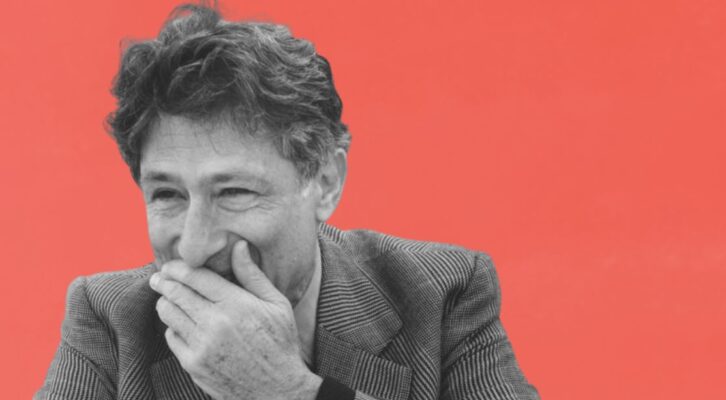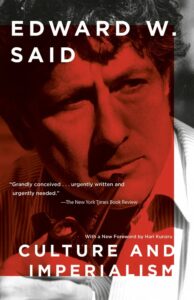
Hari Kunzru Reflects on Edward Said's Culture and Imperialism Thirty Years After Publication
“For every narrative there are counternarratives, and meaningful interpretations of culture arise out of an analysis of tensions and contradictions”
When Edward Said’s book, Orientalism, was published in 1978, it became an instant landmark of scholarship about the European imagination of “the East.” The construction of an alternate world of passion, sensuousness, despotism, and irrationality flattered Western sensibilities during the colonial period, and licensed brutality that otherwise might have seemed to run counter to the ideals of Christianity and the Enlightenment. After its publication, Said realized he wanted to think further about imperialism and the various ways in which colonized people resisted it. He also wanted to understand how the experience of empire marked the culture of the colonizers.
Culture and Imperialism, the book that resulted from this research, is above all about the novel, “the aesthetic object whose connection to the expanding societies of Britain and France is particularly interesting to study.” Said’s readings have become canonical. No scholar of Heart of Darkness can avoid reckoning with the way Conrad’s “exilic marginality” complicates the novel’s imperialist politics and aesthetics. Likewise the écriture blanche of Camus’s The Stranger no longer seems like the innocent vehicle for the expression of existentialist universals about “the human condition” but a style invested in a certain sort of willful silence about history.
A novel, Said quips, “is neither a frigate nor a bank draft.” It’s neither a transparent expression of class ideology nor a tool for the exercise of authority. Its primary purpose is not to control people or accumulate power, except perhaps incrementally, in the form of a kind of silting up of canonical importance. Nevertheless, novels “participate in, are part of, contribute to an extremely slow, infinitesimal politics that clarifies, reinforces, perhaps even occasionally advances perceptions and attitudes about . . . the world.” Said’s famous reading of Jane Austen’s Mansfield Park still has the power to scandalize, at least among those who see themselves as guardians of British heritage. He reminds us that the Bertram family’s wealth derives from sugar plantations in Antigua. There’s almost no mention of Antigua in the novel, yet without it, Mansfield Park would not exist. It’s not simply that the house has been built using profits from slave labor, but that the aesthetic and moral order it represents, its “poise and beauty” separates the masters from their invisible workers, authorizing the cruel treatment of lesser creatures who do not possess “civilized” refinements.
In 2020, the National Trust, the body that administers many British monuments, including numerous country houses, produced a report on the connections between colonialism, slavery, and properties in their care. Immediately, conservative politicians and commentators accused it of “hectoring” and “lecturing,” instead of providing the apolitical experience of “beauty” they required. The backlash was so severe that its director received anonymous death threats, and the board chair was forced to resign. Said’s work, and the perspective it engenders, is still, in the twenty-first century, too much for those who cannot accept that the wish to bring light to the earth’s dark places also contains within it the desire to “exterminate the brutes.”
Said’s work, and the perspective it engenders, is still, in the twenty-first century, too much for those who cannot accept that the wish to bring light to the earth’s dark places also contains within it the desire to “exterminate the brutes.”
More than thirty years after its publication, the experience of reading Culture and Imperialism is, in a favorite formulation of its author, “contrapuntal.” This is, of course, a musical metaphor, and within the idea of counterpoint Said was seeking a model for critical reading, a way to bring disparate fields of knowledge into a relationship with each other. Contrapuntality meant that “we must be able to think through and interpret together experiences that are discrepant, each with its particular agenda and pace of development, its own internal formations, its internal coherence and system of external relationships.” This involves reading the periphery back into the core, the claims of colonizers against those of the colonized, and exposing the structural dependence of the Western canon on what is left out of it; for every narrative there are counternarratives, and meaningful interpretations of culture arise out of an analysis of tensions and contradictions. Contrapuntality doesn’t have the productive force of a dialectic, and in using it Said seemed to wish to distance himself from the tradition of Marxist critical theory. Nevertheless, he was careful to claim that by making oppositions “concurrent” he was not aiming for some serene symphonic totality but “an atonal ensemble,” a soundscape that reflects “a complex and uneven topography.”
For the twenty-first century reader, Culture and Imperialism’s contrapuntality is partly temporal. There are aspects of the book that feel startlingly contemporary, interventions into debates that we’re used to thinking of as belonging to the present moment, and are surprised—and perhaps also slightly depressed—to find fully formed in its pages. Sallying forth against an overheated column by the British Orientalist Bernard Lewis, who claimed that such evils as slavery and polygamy would ensue if the canon of Great Books taught in American universities were modified to include more work by women and non-Europeans, Said remarks drily that this is symptomatic of “a highly inflated sense of Western exclusivity in cultural accomplishment, but also of a tremendously limited, almost hysterically antagonistic view of the rest of the world.” Already, in 1992, the debate about “decolonizing the curriculum” was in full swing.
There are aspects of the book that feel startlingly contemporary, interventions into debates that we’re used to thinking of as belonging to the present moment, and are surprised—and perhaps also slightly depressed—to find fully formed in its pages.
Said had little choice about becoming a fighter in the culture war. His position as a Palestinian American made it unavoidable. The first intifada began in 1987, and Said’s attempts to interpret the Palestinian position for his audience were willfully misinterpreted as uncritical advocacy, or worse. Such attacks were painful to a man who insisted that he was not writing out of “retrospective vindictiveness” but “a fortified need for links and connections,” an impulse to build what would later be called counter-globalization. Instead he was caricatured as a partisan in a conflict “so globally all-encompassing; there was no way of not being involved.” Along with the savagery of the War on Terror came an intensification of the Orientalist discourse that Said prepared us to interpret. After Al Qaeda and the Islamic State, it’s hard to think back to a moment when the impeccably dressed opera lover, the secular Ivy League professor with an attachment to the Protestant tradition in which he grew up, would make a satisfying villain for a right wing culture war. That said, his very cosmopolitanism, his failure to conform to Orientalist stereotype, also contributed to his discursive threat.
Culture and Imperialism was written at a moment when the world was emerging from the ossified binary of the Cold War into what Said calls “a new period of vast uncertainty.” There were new possibilities for mobility, but also of dislocation, emerging forms of freedom and new modes of oppression. Contrapuntally, against the book’s contemporaneity, it can also be read as a document of the culture and geopolitics of the high neoliberal era of the late 1980s and early 1990s. The period between the fall of the Berlin Wall and 9/11 was one of vast confidence and strange political drift, as old imperatives ceased to matter and the contours of a different geopolitical order emerged.
After Al Qaeda and the Islamic State, it’s hard to think back to a moment when the impeccably dressed opera lover, the secular Ivy League professor with an attachment to the Protestant tradition in which he grew up, would make a satisfying villain for a right wing culture war.
“During the time I have been writing this book, the crisis caused by Iraq’s invasion and annexation of Kuwait has been in full flower,” Said writes. “Two central ideas clearly were held over from the past and still hold sway: one was the great power’s right to safeguard its distant interests even to the point of military invasion; the second was that lesser powers were also lesser peoples, with lesser rights, morals, claims.” This is a typical Saidian move, an attempt, via a historical long view, to provide a counterpoint to the speed and weightlessness of media commentary. When he states that “we belong both to the period of colonialism and of resistance to it,” we’re reminded that this is a writer who was born in Jerusalem in 1935, when it was still part of the British Mandate of Palestine.
As an intellectual who came of age in the period of decolonization, Said understood what Fanon called “the pitfalls of nationalist consciousness.” The liberation movements that had swept away the European powers relied heavily on a politics of national identity, often committing themselves to the restoration of some feeling of organic unity, supposedly suppressed by Empire. Fanon argued that, in Said’s words, “unless national consciousness at its moment of success was somehow changed into a social consciousness, the future would hold not liberation but an extension of imperialism.” This was, in effect, what happened, and when Said characterizes Desert Storm unequivocally as “an imperial war against the Iraqi people, an effort to break and kill them as part of an effort to break and kill Saddam Hussein,” he is lamenting the injustice of punishing the masses for the sins of corrupted decolonial nationalist leaders. In the euphoria over the quick liberation of Kuwait, Said’s analysis was unpopular in elite American circles, where the logic of “humanitarian intervention” was taking hold. Yet in its very elevation, that logic—the sense of mission, even of historical necessity—would gradually take on a fully imperial character, as the view became widely held that “democracy” could be installed in a conquered nation, like a new operating system on a computer. A little over a decade later, as American troops fought insurgents while would-be democracy installers cowered in Baghdad’s Green Zone, Said died, having watched, like Walter Benjamin’s angel of history, as the wreckage of the catastrophe piled up at his feet.
Said’s central claim in Culture and Imperialism is that “the map of the world has no divinely or dogmatically sanctioned spaces, essences, or privileges. However we may speak of secular space, and of humanly constructed and interdependent histories that are fundamentally knowable, although not through grand theory or systematic totalization.” Thirty years on, this is still contentious. The age of high imperialism may be a historical memory, but it is still part of the present. Powerful interests still authorize themselves through various forms of systematic totalization, whether under the sign of technocratic rationality or divine right. The idea of a localized, pragmatic, situated understanding of the world still has many enemies, as does the project of Palestinian statehood, that lies at the core of Said’s work. As the great Palestinian poet Mahmoud Darwish wrote in Edward Said: A Contrapuntal Reading, “If the past is only an experience / make of the future a meaning and a vision / Let us go.” In this, he is still our contemporary.
_______________________

From Culture and Imperialism by Edward Said. Introduction by Hari Kunzru. Copyright 2025 by Hari Kunzru.
Hari Kunzru’s latest book, Blue Ruin, is available now from Knopf. You can read an excerpt here.
Hari Kunzru
Hari Kunzru is the author of seven novels, Blue Ruin, Red Pill, White Tears, Gods Without Men, My Revolutions, Transmission, and The Impressionist. He is a regular contributor to The New York Review of Books and writes the “Easy Chair” column for Harper’s Magazine. He is an Honorary Fellow of Wadham College Oxford, a Fellow of the Royal Society of Literature, and has been a Cullman Fellow at the New York Public Library, a Guggenheim Fellow, and a Fellow of the American Academy in Berlin. He teaches in the Creative Writing Program at New York University and is the host of the podcast Into the Zone, from Pushkin Industries. He lives in Brooklyn.



















